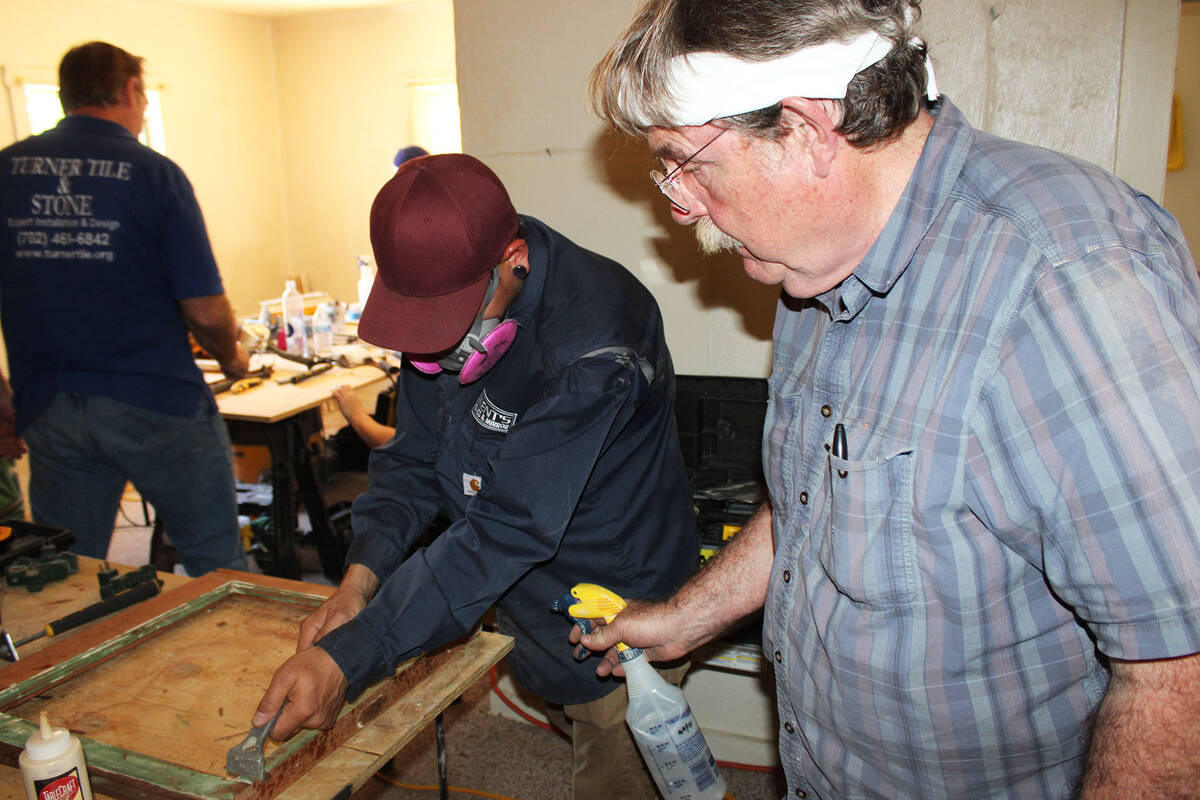
When Bob Yapp learned the restoration crafts he now teaches to others, there was no one around to teach him.
“There was no one to teach us, we had to figure all of this out for ourselves,” Yapp said as eight students put the final touches on four newly-restored windows in the historic home at 640 Avenue C. The students and Yapp were there for a workshop sponsored by the city.
When the workshop was first announced last year, now-Acting City Manager Micheal Mays said, “Both Boulder City and the city of Las Vegas have heard from property owners that want to restore windows in historic properties but cannot find contractors that are knowledgeable in the trade.”
Indeed, it was more of a challenge than expected even finding people who wanted to learn and get the training at no cost. The workshop was originally slated to have 12 participants restore six windows, but with only eight participants (plus Yapp and his team), four windows were actually completed. Actually, the layman would probably think of it as eight actual windows as each opening has two window elements referred to as a sash.
Each window opening is a process and involves significant work.
“We remove each sash, remove the glass and then —safely —remove the old lead-based paint,” Yapp explained.
Each opening is repaired with an architectural putty being used to replace rotting or missing wood. The actual glass is then reset into the sash. Participants installed aluminum slide channels into each opening so that the sash would move freely for years to come. Finally, the sashes were re-installed and the original spring-loaded sash pins set and adjusted so that each sash would stay up when it is opened. It is a process that Yapp says is more important than just the way it honors history.
“There is nothing more green than restoring an old building and saving it from the landfill,” he said.
While his PBS TV show, “About Your House with Bob Yapp” ended its five-year run in 2000, Yapp has since taught thousands what he has learned over a lifetime of restoring old houses.
“Look,” he explains. “We were just a bunch of hippies in the Midwest trying to get into houses we could actually afford to buy and they had all of these problems. And we figured out how to fix those.”
He continues to teach others how to overcome the same problems both through his Belvedere School for Hands-On Preservation in his home base of Hannibal, Missouri and as a traveling teacher. He likens himself to something along the lines of an old-time circuit rider. In the 19th century, there might have been just one judge or sheriff or doctor who served a huge geographical area and who rode a circuit, spending some time in each town or outpost along the way.
“I’m like that but I’m the preservation guy,” he said. “We go on the road and we teach masonry, floor restoration, window restoration, we do a lot of things, but window restoration seems to be a big issue for a lot of communities.”
The specific house where the work was done — located at 640 Avenue C — is owned by the Boulder City Museum and Historical Association, which has a goal to fully restore the building to its original 1931 condition using period-appropriate construction methods and materials. The homes in the area, referred to as “dingbat houses,” were constructed in 1931 as temporary housing for some dam workers and were never intended to last. Most of the houses up and down Avenue C have been updated and most have been expanded as well. The 640 house is one of very few that is still in largely the same condition it was in when it was built.
The first day of the workshop coincided with the one day so far in 2024 where the temperature outside briefly hit the century mark, making the process tougher as the paint removal process necessitates the use of heat guns to soften the old paint and safety considerations meant everyone had to wear masks while that process was live.
By the final day, Sunday, the heat had taken a toll and everyone was moving a bit slower. Yapp sat directing, offering direction and reminding students of things they had already learned. When the sash was ready to be reinstalled, he got up, grabbed a power drill and a nail gun. He showed them how to nail in the new channel sheath and drilled the holes for the sash pins.
When the installed window was raised into its up position and the pins snapped into place, Yapp smiled. “That is how you do it.”